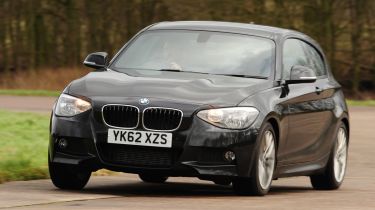BMW 118d M Sport
Can the rear-wheel-drive fun help offset the BMW 1 Series’ higher price?
We’re still big fans of the BMW 1 Series, but the mid-range 118d doesn’t have the best engine in the range. It falls into the middle ground between economy and performance, yet doesn’t excel at either. While the rear-drive chassis is entertaining, the BMW looks gawky compared to the stylish SEAT. A higher purchase price confirms its second-place finish.
The BMW 1 Series is a great driver’s car and was crowned Best Compact Hatchback at our New Car Awards 2012. But it hasn’t won any prizes for its beauty. The awkward proportions contrast starkly with the Leon’s elegant styling, and dark colours don’t do it any favours, either.
Our M Sport model features deeper front and rear bumpers, but they’re not enough to ensure the 118d outshines its rival.
At least the interior has an air of high quality. M Sport cars boast sports seats partly trimmed in luxurious Alcantara upholstery with a honeycomb mesh finish, while the steering wheel and gearlever also get M branding.
The dash has a straightforward layout, and the optional 6.5-inch widescreen sat-nav display fitted to our car provides crystal-clear mapping. However, the orange backlighting used in parts of the dash looks dated when compared to the SEAT’s classy white-on- black digital dash readouts.
Used - available now

2019 BMW
1 Series
36,780 milesAutomaticPetrol3.0L
Cash £22,250
2024 BMW
1 Series
27,841 milesAutomaticPetrol1.5L
Cash £21,999
2020 BMW
1 Series
23,003 milesManualPetrol1.5L
Cash £16,697
2019 BMW
1 Series
17,170 milesAutomaticPetrol3.0L
Cash £22,699Interior space is reasonable, although there’s not as much rear legroom as in the Leon. The boot is smaller, too, offering 360 litres of luggage space. At least you get a low load lip and rear seats that fold down flush with the floor. Of course, the car in our pictures isn’t as practical as the Leon due to its three-door layout, although it costs £530 less than the five-door 118d we tested.
Whichever body you choose, all 1 Series get BMW’s range of EfficientDynamics technologies. As well as stop-start, the 118d has brake energy recovery and EcoPro driving mode, which optimises the throttle and climate control to boost efficiency. The 2.0-litre diesel in the 118d makes 141bhp, and when driven in isolation, the car doesn’t feel noticeably short of power. But it trails the more potent SEAT when it comes to straight-line acceleration.
Still, while it’s not as quick as its rival, the BMW demonstrates that rear-wheel drive is still the way to go for pure driving thrills. The steering is communicative and the balanced chassis means the 1 Series is very rewarding to drive fast. This is helped by a crisp six-speed manual gearbox, thick-rimmed steering wheel and low-slung seating position.
Despite all this, the BMW isn’t as far ahead of the SEAT as it once was. You can only appreciate the difference between front and rear-wheel drive at the very limit of grip on the test track.
Unfortunately, BMW still asks buyers to pay a premium for the 1 Series’ rear-drive set-up. Our £24,685 test car cost £1,310 more than the Leon, and you’d have to pay a lot more for a BMW with similar performance, although both cars are similarly equipped.
Running costs are quite closely matched, as residual values and fuel economy are similar. Where the 118d does have an advantage is servicing: it’s currently offered with a three-year, fixed-price deal that costs only £375.
So the BMW still has the edge when it comes to handling, but the figures may not add up to all-round satisfaction.







